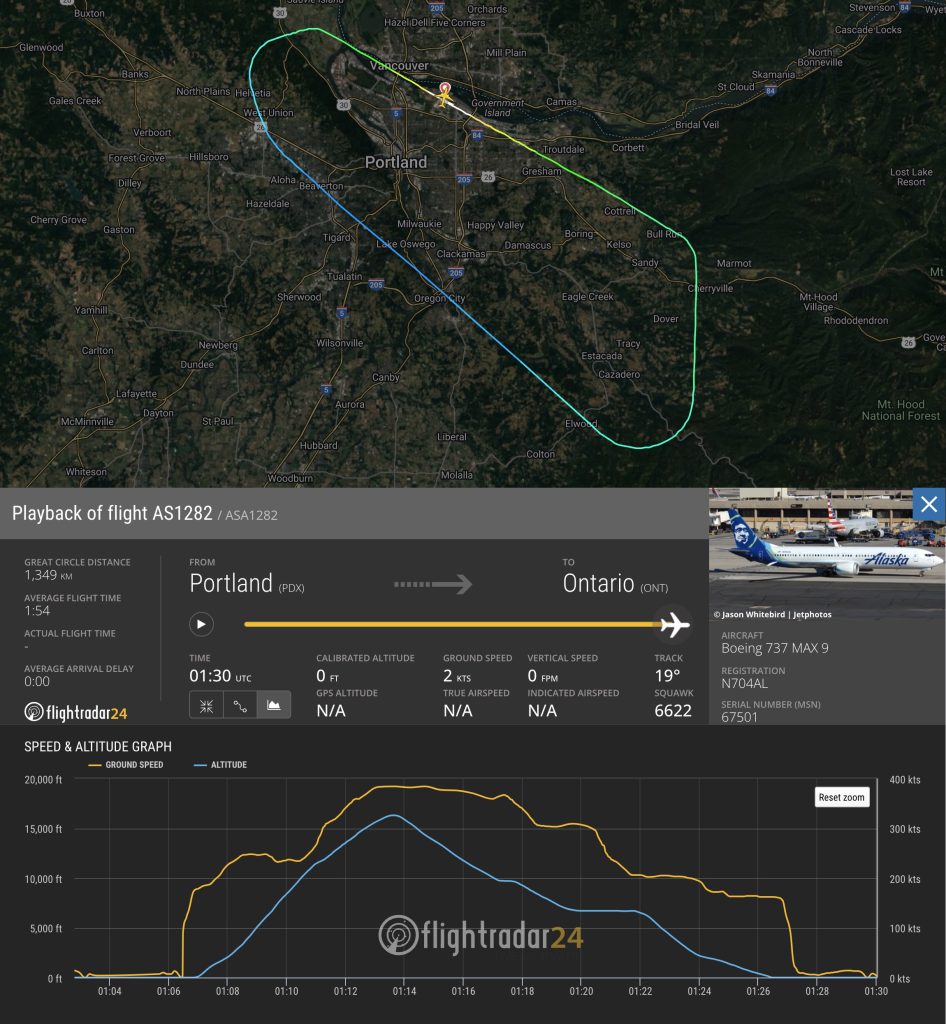The rear mid-cabin exit door plug separated from an Alaska Airlines 737-9 MAX minutes after take off from Portland on 5 January. The aircraft, registration N704AL, departed Portland (PDX) bound for Ontario, CA (ONT) at 17:06 local time (01:06 UTC +1). The aircraft reached a maximum altitude of 16,325 feet AMSL. It diverted safely back to Portland, landing at 17:26, reaching the gate at 17:30. The flight was carrying 171 passengers and six crew.
According to granular ADS-B data received from the aircraft, times in UTC:
Take off: 01:06:59Climb through 10,000 feet AMSL: 01:10:29Maximum altitude (16,325 ft AMSL): 01:13:41Descent below 10,000 ft AMSL: 01:17:02Touchdown: 01:26:28Gate arrival: 01:30:04
Download AS1282 data
The mid-cabin exit door
On the 737-9 MAX, Boeing includes a mid cabin exit door aft of the wings, but before the rear exit door. This is activated in dense seating configurations to meet evacuation requirements. The doors are not activated on Alaska Airlines aircraft and are permanently “plugged.” The door position in question is highlighted below inside the red circle.
737-9 MAX N704AL Aircraft information
N704AL (MSN 67501) was delivered to Alaska new from Boeing on 31 October 2023. It entered commercial service on 11 November 2023 and has accumulated 145 flights since then (including the incident flight).
AS1282 was the aircraft’s third flight of the day and second take off. It had flown from San Diego to New York overnight and then on to Portland earlier in the day.
FAA issuing Emergency Airworthiness Directive
The FAA issued an Emergency Airworthiness Directive on 6 January requiring inspections of all 737-9 aircraft with a mid-aft cabin exit door plug. The full text of the EAD may be viewed by clicking on the image below.
Airlines grounding their 737-9s for inspection
Following the FAA’s emergency airworthiness directive, Aeromexico and Copa Airlines announced the grounding of their 737-9 MAX fleets, which number 19 and 21, respectively. Copa operates eight additional 737-9 aircraft in a door configuration not subject to inspection. Turkish Airlines has also grounded their fleet of five 737-9s pending inspection.
Alaska Airlines and United Airlines continued to operate some 737-9 MAX flights the day following the accident due to the aircraft having recently undergone heavy maintenance and inspection. Late in the day on 6 January, however, both airlines grounded their entire 737-9 fleets, saying they are awaiting guidance on the inspections required by the FAA’s EAD.
EASA adopts FAA directive
*Iceland is not an EU member, but subject to EASA regulations
8 January — FAA approves inspection method
The FAA now says it has “approved a method to comply with the FAA’s Boeing 737-9 emergency airworthiness directive, and it has been provided to the affected operators.”
Affected 737-9s will stay grounded until “operators complete enhanced inspections which include both left and right cabin door exit plugs, door components, and fasteners.” Any deficiencies must be corrected before an aircraft can return to service.
9 January — FAA says inspection method of compliance not yet finalized
A day after saying that a method to comply with its emergency airworthiness directive had been approved, the FAA issued the following statement:
“Every Boeing 737-9 Max with a plug door will remain grounded until the FAA finds each can safely return to operation. To begin this process, Boeing must provide instructions to operators for inspections and maintenance. Boeing offered an initial version of instructions yesterday which they are now revising because of feedback received in response. Upon receiving the revised version of instructions from Boeing the FAA will conduct a thorough review.
The safety of the flying public, not speed, will determine the timeline for returning the Boeing 737-9 Max to service.”
11 January — FAA opens formal investigation into Boeing quality
The Federal Aviation Administration notified Boeing today that it has opened an investigation “to determine if Boeing failed to ensure completed products conformed to its approved design and were in a condition for safe operation in compliance with FAA regulations.”
In its letter notifying Boeing of the investigation, the FAA notes that the circumstances of the door plug departing the Alaska Airlines aircraft and the subsequent findings during pre-inspection work on other 737-9s may “indicate that Boeing may have failed to ensure its completed products conformed to its approved design and were in a condition for safe operation in accordance with quality system inspection and test procedures.”
The post Alaska Airlines 737-9 MAX exit door plug separates in flight appeared first on Flightradar24 Blog.
